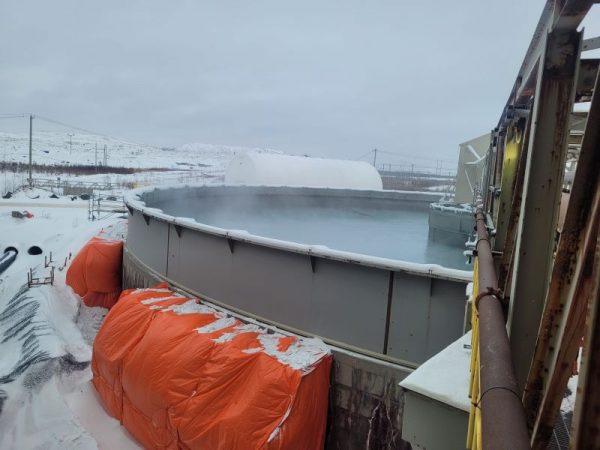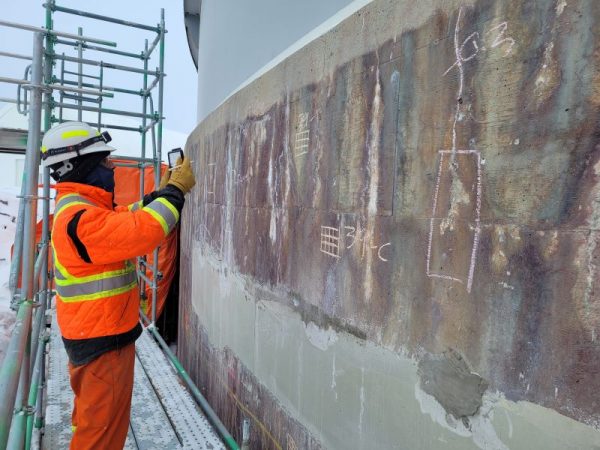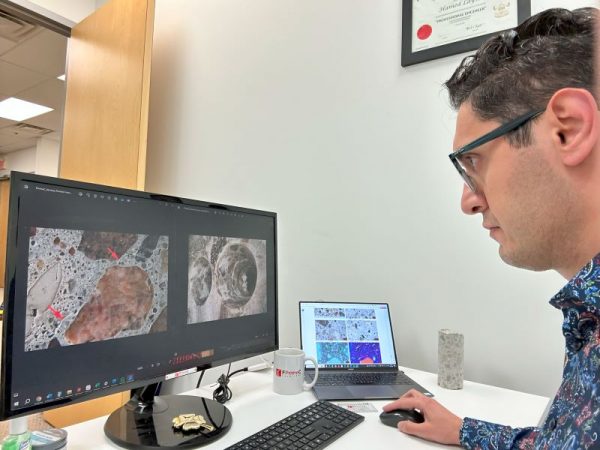Deterioration of a Concrete Thickener Tank
FPrimeC was engaged by the client to evaluate the present condition of a Concrete Thickener Tank in a Gold Mine facility in Ontario, Canada. A preliminary assessment of the tank revealed the following key problems concerning the durability and structural integrity of the concrete structure:
- Degradation of concrete
- Extensive concrete cracking
- Weeping/leaking cracks
- Localized sign of soft and loose concrete) of concrete thickener tank.

Formulating the Right Condition Assessment Plan
Upon reviewing the initial data and results from the preliminary site visit, and further communication with the client, FPrimeC formulated a comprehensive structural condition assessment program to evaluate the structural and durability performance of the tank, and identify all repair and maintenance needs. The main objective of this condition assessment was to:
- Assess the existing condition of the thickener tanks
- Determine the root cause of the problem (poor quality concrete vs. chemical attack by material inside tank)
- Identify the extent and severity of defects; and
- Provide preliminary repair/rehabilitation options.
The detailed digital inspection followed by a comprehensive multi-technology Nondestructive Testing and Evaluation (NDT-E) program for the condition assessment of concrete thickener tank. The Nondestructive evaluation was validated through a carefully designed intrusive assessment and involved obtaining a limited number of core samples for compressive strength evaluation, as well as petrography examination.
- Digital Inspection (LiDAR capture)
- In-Situ Non-Destructive Testing:
- Ultrasonic Pulse Velocity
- Ultrasonic Pulse-Echo (UPV)
- Rebound Hammer (RH)
- Concrete Core Extraction:
- Compressive Strength
- Petrographic examination,
- Surface Electrical Resistivity
- Cross Width Ultrasonic Pulse Velocity
Digital Inspection of Concrete Tanks
With a total outer diameter of 53m, and an average free height of 4m, the exterior area of concrete thickener tank was more than 600 m2. FPrimeC used a unique digital inspection technology to map the visual condition of the tank using 3D LiDAR capture, laser measure and camera. For this inspection, the Ontario Structure Inspection Manual (OSIM) and ACI Visual Condition Survey of Concrete- Guide (ACI PRC-228.4-23) were used. Where applicable, a standard crack width gauge was used to determine the crack width at multiple test stations along the length of each crack.
The procedure allowed FPrimeC to map out all major anomalies on the surface in an incredibly short timeline (less than 8 hours). The LiDAR captures were stitched and analyzed using our in-house suit of software.

In-Situ Non-Destructive Testing of Thickener Tank
1. Ultrasonic Pulse Echo
Ultrasonic Pulse Echo (UPE) was used to investigate the quality and structural integrity of the concrete, based upon ACI Committee 228 standards. The UPE testing consists of a dry contact shear transducer array, which does not require coupling agent between the transducers and concrete surface. This technique transmits a stress pulse into the material, which propagates and reflects off flaws or interfaces. By analyzing the time it takes for these waves to travel and knowing the material’s speed, thickness can be evaluated. The results helped FPrimeC identify areas with potential sub-surface anomalies and defects.
2. Schmidt Hammer (Rebound Hammer)
The Rebound Hammer test was used to assess uniformity and quality of the concrete. This method has been developed through different standards and guidelines such as the ASTM C 805 “Standard Test Method for Rebound Number of Hardened Concrete”, and ACI 228.1R “In-Place Methods to Estimate Concrete Strength”. This test consists of measuring the rebound of a spring driven hammer mass after its impact with concrete. The rebound test helped FPrimeC engineers identify areas with potential surface anomalies across the large area of the thickener wall.
Intrusive Assessment
To provide further information on the condition of the concrete, concrete core samples were extracted from the concrete surface at strategically selected locations. The results of preliminary inspection and nondestructive testing helped identify the most appropriate location for extracting concrete samples. The core samples were taken for additional non-destructive testing, visual examination, compressive strength, and petrographic examination.
1. Ultrasonic Pulse Velocity
Ultrasonic Pulse Velocity (UPV) was performed on core samples to assess the overall quality, uniformity and homogeneity of the concrete cores, based upon ASTM C 597 standards. This method involves transmitting high-frequency sound waves through the concrete using transducers placed on its surface and recording the time taken for the waves to travel between them. The UPV measurements were taken with two different adaptations to better assess concrete cylindrical cores. The first adaptation places both transducers on the ends of the cylindrical specimen, evaluating the velocity in the longitudinal direction inside the core.
The second adaptation places the transducers on opposite sides; 180° apart along the curvature of the cylinder, and takes separate UPV reading at specific intervals on the core profiles. This method examines the consistency of the velocity across the depth of the core, which can further indicate if there is much change in quality between the outside and inside face of the tank.

2. Surface Electrical Resistivity for Durability of Concrete
Surface Electrical Resistivity testing was used to assess the penetrability of concrete against chloride ion, based on AASHTO T358, 2015. The test was performed using a common 4-Pin Wenner Probe. The test results allowed engineers get a better understanding of the porosity of concrete materials. Another objective was to identify if the concrete material had a porous structure, or if the materials inside the tank might have caused the deterioration of the tank.
3. Compressive Strength of Concrete
Compressive strength testing on concrete cores involves extracting cylindrical samples from hardened concrete structures. The core samples were trimmed, ground plane, and tested for compressive strength in accordance with CSA A23.2‐14C. The test results helped FPrimeC and the client better understand the impact of the ongoing deteriorations on the mechanical properties of concrete.
4. Concrete Petrography
Concrete Petrography testing on concrete cores was performed to examine thin sections of extracted cylindrical samples under a polarizing microscope to assess the mineralogical composition, microstructure, and the presence of defects such as cracks, voids, and aggregate-paste interface issues. This technique is based upon ASTM C856.
The Petrography test was conducted on cores extracted from good locations, as well areas exhibiting sign of extensive deterioration. The petrography test was designed to help FPrimeC with key information on the nature of cracks, assess potential Alkali-Silica Reactions, Assess possibility of Sulphate attack, or any other chemical attack in concrete (internal or external).

Summary
A multi-technology condition assessment approach was designed for structural condition assessment of a deteriorating concrete thickener tank in a mining facility in Canada.
- Advanced Digital Inspection significantly reduced the inspection timeline while allowing for a location bases assessment and accurate LiDAR measurements.
- Nondestructive Testing allowed FPrimeC engineers to locate potential subsurface defects. The proposed methodology significantly reduced the number of cores needed for the assessment.
- A limited intrusive assessment was designed to validate the findings of the nondestructive testing program.
- Petrography testing of concrete allowed for identifying potential root causes of the deteriorations.
- A preliminary repair procedure along with repair materials was prepared.
